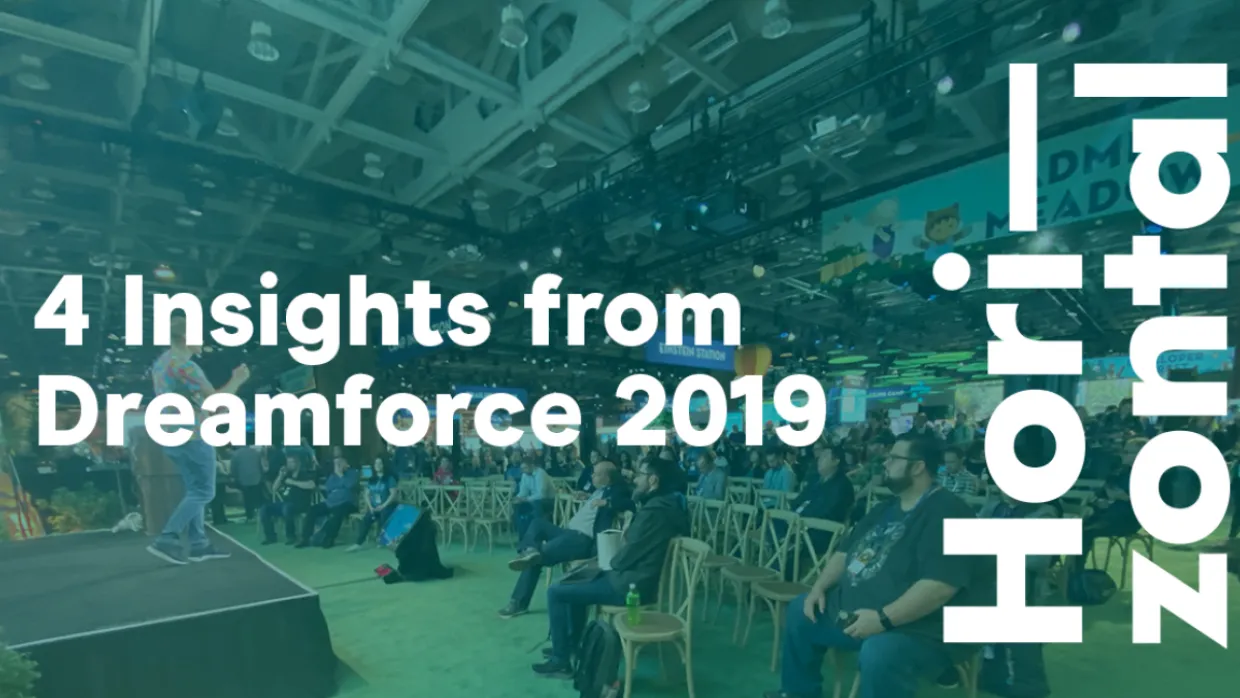Personalization
4 Insights from Dreamforce 2019

Dreamforce 2019 was a whirlwind—and the Horizontal Digital team took San Francisco by storm. We led several speaker sessions on Salesforce tools, hosted Cross-Cloud happy hours and monitored a Women in Tech panel discussion on the Fourth Industrial Revolution. Throughout Dreamforce week, our team also had the opportunity to expand their knowledge base at hundreds of instructional demos and keynote speeches. Here are a few of our biggest takeaways:
Roscoe Dixon, Senior Solution Architect
Salesforce continues to roll out tools to help Salesforce administrators deliver better experiences for their customers with no need for code. For this reason, soft skills are in high demand. Businesses aren’t just looking for instructions on how to build specific tools—they need experts who can train them how to harness the power of Salesforce.
In my opinion, the speed at which Salesforce is enabling AI and other new technologies will surely outpace adoption. This makes soft skills all the more valuable. Consultants can get you up to speed on these tools faster and give you a huge competitive advantage.
Matt Wash, Senior Cross-Cloud Consultant
Fundraising add-ons to the Non-Profit Cloud and Education Cloud are enabling organizations to engage faster and smarter. Merchant accounts can connect with minimal friction, and Einstein is leveraging donor data to create drag-and-drop donation pages with personalized gift amounts. On the education side, AI helps school staff diagnose student issues early on and provides recommended courses of action.
Volunteer management in Salesforce is now a snap with volunteer landing pages that allow admins to configure shifts, manage demand for specific skills and tie data to an existing contact record. Einstein Voice is making breakthroughs in natural language processing. Decision makers can now interact with Einstein via voice chat and respond with insights to data in real-time.
And thanks to the Rebel acquisition, interactive email content is allowing marketers to reach new levels of personalization in their users’ inbox. Rebel also emphasizes the importance of trust and consent, to help ensure savvy personalization isn't misinterpreted as “creepy,” damaging customer relationships.
Smitha Praveen, Cross-Cloud Consultant
My biggest takeaway from Dreamforce was exposure to Salesforce Customer 360 Companies have been trying to get a 360-degree view of their customers for years. But with different departments using different tools to manage customer data, disconnected customer experiences are hard to avoid.
To bring all the clouds together, Salesforce Customer 360 was created. It unites your marketing, sales, commerce, service and IT teams with a single view of your customers. It delivers personalized, connected experiences. Customers don’t want isolated point solutions—they want a simple platform that can bring all those things to bear.
I also attended hands-on sessions to get immersed in Sales Cloud, Marketing Cloud and Pardot. I learned how to use Trailhead in a more efficient way, socialized with other Salesforce users and connected with clients. My Dreamforce experience really made me happy I chose a career in Salesforce. I increased my knowledge base at lots of great sessions and gained confidence to do things better in Salesforce.
Jill Minick, Project Manager
I learned a ton at Dreamforce. It's truly difficult to summarize it all, but here's my best shot:
Quip success: Many have achieved success using Quip as a team collaboration tool within a restricted set of templates for kick off, scrum ceremonies and more. Quip makes it easy to set up templates. Governance is gold!
HR Onboarding and IT: I sat through an amazing demo on leveraging Salesforce for HR onboarding and IT tickets using process builder and flows.
The concept of "The world of more:" We live in a fast-paced digital world which provides so many digital options for our customers. How can we help the customer navigate an abundance of options?
I also participated in an enlightening session on project management for admins. The upshot was that everyone should be a PM and take ownership:
- Focus on your primary user.
- Management doesn't have all the information.
- Users know about the real processes.
This session went over some best practices to keep your focus on primary users:
- No more than two users at a time.
- Keep it short (interviews should be less than 15 minutes).
- Focus on average users (not super users).
- Build trust—no managers present.
Finally, this session instructed PMs to do one thing at a time. Don’t multi-task and only start what you can finish. Stick to this flow: start, finish, repeat.